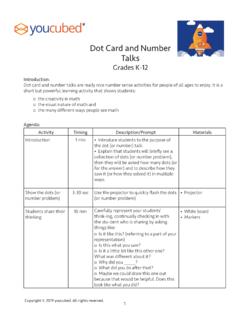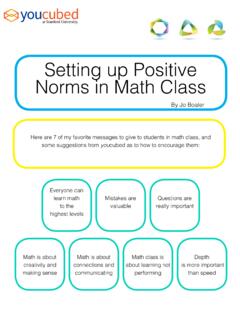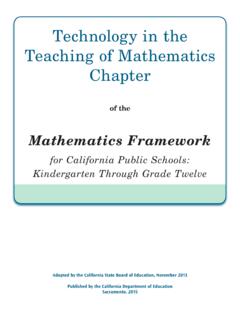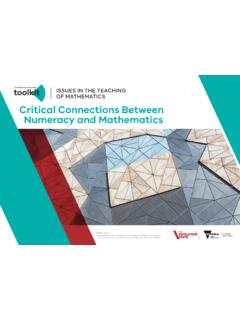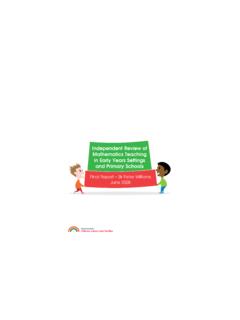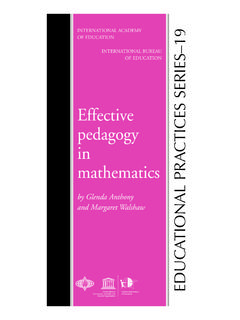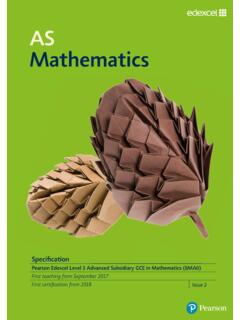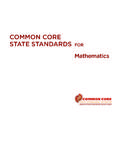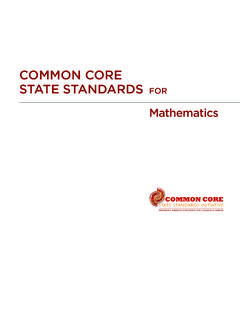Transcription of Ability and Mathematics: the mindset revolution that is ...
1 FORUM. Volume 55, Number 1, 2013. Ability and mathematics : the mindset revolution that is reshaping education JO BOALER. ABSTRACT Recent scientific evidence demonstrates both the incredible potential of the brain to grow and change and the powerful impact of growth mindset messages upon students' attainment. Schooling practices, however, particularly in England, are based upon notions of fixed Ability thinking which limits students' attainment and increases inequality. This article reviews evidence for brain plasticity, the importance of mindset and the ways that mindset messages may be communicated through classroom and grouping practices. In 2006 a trade book appeared on bookshelves that would ultimately have one of the biggest impacts on education of any research volume ever published. In mindset : the new psychology of success (2006a) Carol Dweck summarized key findings from her research on the nature and impact of different mindsets.
2 The book quickly became a New York Times best-seller, a BBC news headliner, and was translated into more than 20 languages. In it Dweck summarized her research evidence from decades of research with differently-aged subjects showing that when students develop what she has called a growth mindset '. then they believe that intelligence and smartness' can be learned and that the brain can grow from exercise. The implications of this mindset are profound --- students with a growth mindset work and learn more effectively, displaying a desire for challenge and resilience in the face of failure. On the other hand, those with a fixed mindset ' believe that you are either smart or you are not. When students with a fixed mindset fail or make a mistake they believe that they are just not smart and give up. Such students frequently avoid challenge, preferring instead to complete easier work on which they know they will succeed.
3 Dweck's studies show that around 40% of US students display a growth mindset and 40% a fixed mindset , while the remaining 20% show mixed profiles. When students undertake an intervention to move them from a fixed to a growth mindset they immediately start performing at higher levels in school 143. Jo Boaler (Dweck, 2006a). The student intervention that has been developed is an online program targeted at middle school students (ages 11-13) that shows them the plasticity of the brain and the impact of brain exercise on the growth of intelligence.[1]. Neuroscientists now have extensive evidence of brain plasticity, some of the evidence coming from people who have suffered major brain lesions, who have gone on to learn reading, writing, bike riding and other abilities that required the brain to grow in response to effort (Bunge et al, 2007; Beilock, 2011).
4 What scientists now know about brain plasticity has serious implications for teaching and grouping structures that are based upon ideas of fixed Ability and limited student potential (Boaler, 2010). Numerous studies have shown the effects of growth mindset interventions on students' achievement, at all ages. Aronson et al (2002) looked at the impact of a growth mindset intervention on college students, comparing two control groups ---a multiple intelligence intervention and a no-treatment control --- with students receiving a growth mindset treatment. While the control groups showed no change in achievement, the growth mindset intervention led to a clear gain in achievement, particularly for African American students. After the intervention, achievement differences between White and African American students disappeared. In addition, the African American students in the growth mindset group showed a significant increase in their valuing and their enjoyment of courses.
5 Blackwell et al (2007) performed a growth mindset intervention with minority students in the USA (African American and Latino) making the transition to 7th grade, many of whom were already showing declining grades. The control group received eight sessions of training in study skills, while the growth mindset group received eight sessions of study skills plus training in the growth mindset . The key growth mindset message was that effort changes the brain by forming new connections, and that students control this process. The growth mindset intervention halted the students' decline in grades and started the students on a new pathway of improvement and high achievement. Good et al (2003) also created a growth mindset intervention for 7th grade students and compared it to a control group. In both groups, mentors met with their students in person for 90 minutes in mid-November, and then again for 90 minutes at the beginning of the second semester (end of January); all other communication between mentors and students occurred through e-mail.
6 The growth mindset intervention led to a gain in mathematics achievement test scores and a 4-point gain in reading achievement test scores. In the control group, there was a highly significant gender difference in mathematics , but in the growth mindset group the gender gap was largely eliminated. Research evidence that has been collected over the last decade leading to new understandings of the brain, Ability and learning has important implications for schools, in particular the Ability -based practices and messages that prevail. The most successful countries in the world base schooling and grouping 144. Ability AND mathematics . practices on growth mindset messages and beliefs, communicating to students that learning takes time and is a product of effort (Stigler & Hiebert, 1999;. Sahlberg, 2011). Many Asian countries, particularly those in the Pacific Rim, have education systems that are based upon the idea that learning is a process determined by effort, rather than fixed notions of Ability (Stigler & Hiebert, 1999).
7 The idea of separating students into different levels is thought to be undesirable or even unacceptable, as reflected in the following commentary about education in Japan: In Japan there is strong consensus that children should not be subjected to measuring of capabilities or aptitudes and subsequent remediation or acceleration during the nine years of compulsory education. In addition to seeing the practice as inherently unequal, Japanese parents and teachers worried that Ability grouping would have a strong negative impact on children's self-image, socialization patterns, and academic competition. (Bracey, 2003, pp. 332-333). But schools in other countries that score significantly lower on international tests, including England and the United States of America, frequently base their schooling practices upon ideas about Ability that have now been shown to be incorrect.
8 Whereas research shows the plasticity of the brain and the Ability of students to develop smartness through hard work and challenge, some schools bombard students with the messages that Ability is fixed and that some students have talent and intelligence while others do not. This chasm between research evidence and practice is most clearly reflected in the Ability grouping practices used in schools that communicate to students that their Ability is fixed, initiating the harmful fixed mindset beliefs that research has shown detract from students'. learning opportunities throughout life (Boaler, 2005; Dweck, 2006a). Developing Growth mindset Schools Over the last few years I have worked extensively with schools, teachers and districts in the United States of America to help teachers communicate growth mindset messages to students and to teach using practices that enable students to develop growth mindsets.
9 This work started after discussions with school principals who told me that their teachers had all read Dweck's book, and were totally on board' with the ideas, but did not know what it meant for their subject teaching . I have particularly, although not exclusively, worked in mathematics --- the subject area that communicates the strongest fixed Ability messages and thinking (Boaler, 2010). The awareness that Ability is malleable and that students need to develop productive growth mindsets has profound implications for teaching . Teachers and schools constantly communicate messages to students about their Ability and learning (Marks, 2013, this number pp. 29-42), through the practices in which they engage and the conversations they have with students. A true 145. Jo Boaler commitment to the communication and teaching of a growth mindset probably requires examination of all aspects of teaching .
10 Even the tasks that teachers choose allow different opportunities for messages to be communicated to students. In mathematics for example, if students are working on short, closed questions that have right or wrong answers, and they are frequently getting wrong answers, it is hard to maintain a view that high achievement is possible with effort. When tasks are more open, offering opportunities for learning, students can see the possibility of higher achievement and respond to these opportunities to improve. This change is consistent with other work in formative assessment (Black & Wiliam, 1998). The following diagram represents the areas of teaching that I have concentrated upon in my work with teachers in the USA. In the remainder of this article I discuss two of these --- Ability grouping and mistakes. Figure 1. Aspects of Classroom teaching that Communicate mindset Messages.


